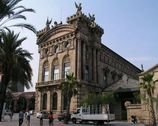

It must be heavens!
No, it's Catalonia...
No, it's Catalonia...
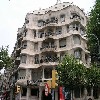
|
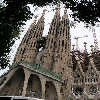
|
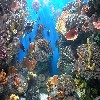
|
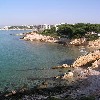
|
No doubts, everyone knows that America was discovered by Christopher Columbus. But did you know that he wasn't Italian but had Catalan origin? As for me, I learned about this recently, during my trip to Catalonia. And did you hear anything about Spanish architector Antonio Gaudi whose amazing masterpieces became the part and parcel of Spain? Ok, I won't confuse you any more and will tell everything l know one after another.
From 28 July till 4 August 2004 I've been nearly in paradise, in Salou to be more accurate (it's in Costa Dorada, Spain). I'll do a stop here as think it could be useful for someone who may go to one's holiday.
So, I went there with Max and we had only a week to spend. We booked our hotel called Cala Font (half board what means that we were given a breakfast and a dinner). We liked the location of the hotel (we saw it on its web site). Also I would like to recommend to check all the possible information regarding a hotel of your choice (some special sites have references and judgements of places people have been in so you can rely on their "picture" of your future hotel).
As our hotel was located quite close to Barcelona (about 100 km) then we with Max decided it in advance that we must go there (we visited Barcelona twice). Then we planned a trip to "capital" of Costa Dorada - Tarragona (again, we learned from the Internet it has a lot of historical places aged from ancient Roman Empire) and it took about 15 minutes to get Tarragona from Salou.
All the time we travelled by ourselves only (I mean that we didn't take any guide with us). Of course, in Salou, like any resort city, you will see much tourist offices that offer guides. But from our experience we understood that much more cheaper to go anywhere without a guide. Pity, we didn't know Spanish language, but we took an electronic dictionary with us so we knew some more common phrases. Bus or train tickets are cheap in Spain. Also there are a lot of tourist offices (as I said it before) and they will give you all the necessary information you may need (say, how to get a definite place, etc) and maps of your or relative towns - so you won't lose your way! I realize that everybody has its own preferences and may feel more sure if one will take a guide. But I'm just telling my story, my choice.
From our 7 days we picked out 3 days (2 days for Barcelona and one - for Tarragona). During other days we swam in Mediterranian Sea and enjoyed walks along Salou.
Sure thing, I won't surprise you if say that we didn't see all the sights we wanted to visit. The reasons for it are the insufficiency of time and... the local heat. Actually, it was the only negative aspect. Round-the-clock heat (30 - 32 degree) made us crazy as after 18 degree in Dublin we felt it like we were on the red-hot frying pan! A trip to any other town was an exhausted business. Though I must say we had such a feeling while walking in the town. If you was going by a bus then everything was ok as every (!) bus or train was well-conditioned, there you could breathe fresh air, not hot and stuffy one. But new problem arises - you can't touch ancient stones, can't see georgeous views from the small window of your bus... that's why we were walking a lot...
Below I will enumerate some sights or attractions which we visited and that are highly recommended by book-guides or other people who have been in Spain. By the way, if you have a desire to see all Barcelona then you should buy a Barcelona Bus Turistic ticket ( for one day or two days). This is the most convenient way to discover Barcelona's most attractive landmarks. You can visit the city's most interesting sights at your leasure, getting on and off the Bus, as many times and for as long as you like, at any of the 40 selected stops. Combine the 3 routes (red, blue and green) as you please and let yourself be transported. A guide given with your ticket contains detailed information about the landmarks and tells you how you can take advantage of the discounts featured with your ticket. (Discounts are valid not for sights only, also you can have a meal in Pizza Hut, McDonald's and Pan's and Company for less. And finally, here are the landmarks...
BARCELONA
Barcino was founded as a Roman colony more than two thousand years ago. That's the reason
why so many buildings have Roman influence on their style, architecture etc. Also Barcelona
is happy to be mother to its famous sons - these are Antonio Gaudi, Salvador Dali, Joan Miro.
Their (as well as other masters') works can be found in the city without ever setting foot in
a museum or gallery, on the streets themselves - more than 500 sculptures and architectural
ornaments to be found in the open air. Part of them can be seen on the page "Monuments".
Casa Batllo
Here we find the best modernista architecture, such as the Casa Batllo, Antoni Gaudi's
masterpiece. More than a building, it has become a legend of the art and architecture of all
time. Built between 1904 and 1906, this year marks its centenary. Today, the First Floor
(the former home of the Batllo family), the Attic and famous chimneys are open to visitors.
La Pedrera (The Casa Milla)
The Casa Mila, better known as "La Pedrera", was built by Gaudi between 1906 and 1910. In this
mature work, the original architect stamps the movement of waves on the imposing stone facade,
highlighting by wrought iron balconies, each of which is different from the others. The interior
of this house, declared Patrimony of Humanity, is full of surprises: the "Espai Gaudi" of the
attic which contains an exhibition of all of Gaudi's work, the impressive roof terrace with
its forest of chimneys covered with tile, and the re-creation of a flat of the period. The main
floor had been remodeled as an exhibition hall and there is an auditorium in the basement.
Sagrada Familia – Gaudi’s dream
The Sagrada Familia is the only "Cathedral" in the world which is still under construction.
It is only funded by churchgoers and devotees, and through ticket revenue from visitors like
you. It is Gaudi's dream, to which he devoted much on his life. At the time of his death in
1926, only one of the towers had been completed. Gaudi was thirty-one years old when he accepted
the commission to build the Sagrada Familia, and this cathedral was going to be the most outstanding
feature of the author's colossal architectural creation; a monumental cupola, nearly one
hundred and seventy metres high, figures among the parts of the church still to be completed.
The continuation of Gaudi's project has become
an unmistakable symbol of Barcelona, not just because of its spectacular size, but because
it also reveals the spirit of a city which always been committed to building its future.
MNAC – The Museu Nacional d’Art de Catalunya
The Museu Nacional d'Art de Catalunya is one of the most important museums in Catalonia. The
MNAC is a must-see and brings together one of the most important museum collections of Romanesque
art in the world. The museum also has outstanding collections of Gothic, Renaissance and
baroque art. As if that wasn't enough, there is always an extremely interesting temporary
exhibition to see. From the Palau Nacional building, which is the museum's headquarters,
built for the 1929 International Exhibition, you can enjoy one of the most glorious views
of the city, with the trade fair precinct and the Magic Fountain in the foreground, which
offers a night-time sound and light show.
Colom - Museu Maritim
This stop is a must for a few reasons. A ride in the lift to the top of the Mirador de Colom
is one of them, as its circular viewing gallery affords breathtaking views of the entire
city. The Christopher Columbus monument, with its height of fifty metres, is one of Barcelona's
best-known landmarks. His index finger permanently points seaward and personifies the city's
recognition of the role the sea had played in its history.Another good reason is a visit to the Museu Maritim, housed in the splendid Gothic building of the Royal Shipyards, where you can see a life-size replica of John of Austria's flagship used at the Battle of Lepanto.
A walk along Barcelona's seaboard allows to discover the commercial port. Next, a sinuous catwalk leads us to the Maremagnum complex, recently built over the waters of the port as a commercial centre. During the first year of its existence, 12 million people have visited its aquarium, cinemas, shops and restaurants.
L’Aquarium
Come and see it yourself! Take a walk down an amazing tunnel, 80 metres under the water's
surface and experience what it feels like to be surrounded by over 8,000 different forms
of marine life.
Other places of interest:
Park Guell - a park, named after Gaudi's patron, Count Eusebi Guell. This park was main source of Gaudi's inspiration.
Futbol Club Barcelona - a hundred-year-old club with over 100,000 members; has been named a 5-star stadium, the highest distinction awarded by the UEFA, due to the quality of its facilities. Without doubts, this stop is a must for lovers of football.
Fundacio Joan Miro - one of Barcelona's foremost museums. House of the permanent collection by this world-renowned Catalan artist who knew how to create his own poetic universe and cultivate a broad spectrum of genres - painting, sculpture, ceramics, tapestries, etc.
Teleferic de Montjuic If you love heights and panoramic views, the Montjuic cable car provides a magnificent opportunity to enjoy your visit.
Museu d'Historia de Catalunya The huge brick building which was used as the main harbour warehouse, is today the home of the Museu d'Historia de Catalunya. Here visitors have the opportunity to take an interactive and innovative journey through the history of Catalonia, from its origins to the present day.
Parc de la Ciutadella - Zoo The Parc de la Ciutadella stands on the site of a military fortress and was built for the Universal Exhibition of 1888. Inside lies the Barcelona Zoo with more than 7,000 animals of 400 different species from around the world. In addition, a walk through the park has a whole host of surprises in store: the spectacular waterfall and navigable lake; the white and glass structure of the Hivernacle, together with the cooling and shady Umbracle; or the Museu de Ciencies Naturals (Museu de Geologia and Museu de Zoologia).
TARRAGONA
Tarragona, the ancient Tarraco, was one of the most important cities in the Mediterranean.
Its historical monuments group is one of the most impressive from ancient times. The acknowledgement
of the Roman Tarragona as Heritage of Humanity reinforces the extraordinary relevance and value
of its archaeological and monumental legacy.Amfiteatre
The amphitheatre is the only building used for spectacles located outside the built-up area,
although it's still close to the city. It was built at the beginning of the 2nd century.
Two types of spectacle were held here: gladiator fights (munera) and fights or simulated
hunts with wild animals (venationes). It was also where prisoners condemned to death were
executed.During the year 221, the amphitheatre was renovated. A few years later, in 259, the Christian bishop Fructuosus and his 2 deacons, Augurius and Eulogius, were burned alive in the arena. This event was commemorated in the 6th century, when a basilica dedicated to the martyrs was built in the arena.
During the 12th century, the Romanesque church of Saint Mary of the Miracle was built on the foundations of the early-Christian basilica.
Catedral
Diocesan Museum, cloister and chapels can be found there. This is the most beautiful cathedral
in Tarragona. Unfortunately, l don't know any facts about it except that the building was
built in 12 - 14 centuries.Balco del Mediterrani
This is an outstanding panoramic view on the seaboard and the port of Tarragona. Here you can
take the most memorizing pictures for you and your family.
Museu Nacional Arqueologic de Tarragona
The museum contains sculptures, mosaics and material culture elements from Tarragona.
Other places of interest:
Circ Roma - building meant for horse and chariot races
Forum Local Roma - remains of a basilica and a Roman street
Aqueducte de les ferreres o "Pont del diable" - roman aqueduct
Palau de la familia Castellarnau - Castellarnan's family palace
Portal de Sant Antoni - Sant Antoni gate.
SALOU
In Salou you can enjoy unforgettable days - the multitude of activities that you may do with
the family gives a feeling of adventure, relaxation, emotions and a lot of fun. That's why
Salou is the number one Catalan tourist destination for families.In the mornings you can go to the beach, sunbathe and do some sports. After this have a lunch in any one of the many restaurants to be found in the Costa Dorada capital. The gastronomy in Salou is varied, high quality with special services for children so that having a good meal in Salou becomes an absolute pleasure.
This resort also offers a multitude of afternoon possibilities. You may enjoy the Mediterranean promenade whilst strolling along the incomparable seafront with the Promenade, the palm trees, the sea,... or discover the culture, commerce, sports, leisure and entertainment, the festivals, etc. Isn't that wonderful holiday to dream about?
Place to see :
Universal Mediterranea - is a never ending world with everything you need for fun end excitement, thrills and relaxation. A world bursting with boundless opportunities to have a good time. Have a look at the site of Universal park.
Positive side of the trip: splendid nature, great rest, cheap products and cost of tickets for public transport (as well as taxi); a lot of facilities for families with children.
Negative side of the trip: heat!!! (but nothing can be done about it...).